Rabbits are not only beautiful fur, but also 3-4 kg of dietary, healthy meat. But in order to get both they need to be properly fed. Especially for beginner rabbit breeders, it is important to know what to feed the rabbits at home in summer and winter, what kind of food to give, when and what is the rate of feeding.
In this article, let's deal with the issues of rabbit breeding.
Table of contents
- Rabbit feed types
- Can rabbits give apples, fruits and berries?
- How to feed animals in summer: herbs, vegetables, watermelons
- What kind of food to give in the winter so that they can gain weight?
- Diet rabbits in the village or on a personal farm
- Feeding regime at home
- Vitamin and mineral supplements for rapid growth
- What can not eat rabbits?
Rabbit feed types
Let's start with what rabbits eat. In order for the rabbits to be agile and healthy, they need a variety of food.
Green food
This type includes freshly cut grass and vegetable greens. They are fed from early spring to late autumn. This food all summer should be plentiful. It helps to reduce the cost of production of rabbit meat, but also they get a complete diet of vitamins and trace elements necessary for active growth and reproduction. Fresh grass before feeding should be slightly dried in the sun.
If you have a small livestock, the green feed conveyor can be provided from the dacha. To do this, select a few small places for sowing alfalfa, peas, sainfoin, a mixture of wiki with peas, oats, rye, or wheat. Oats and peas are planted in the middle of March and thus receive early greens. Rabbits willingly eat corn.
Also from the garden it is useful to give tops from root crops, except for potato and tomato.Dill, celery, horseradish and rhubarb are well eaten. Wherein dandelion and dill are useful for giving to rabbits when feeding rabbits with milk. Useful for vegetable gardens and rabbits. Weeding: dandelion, wheatgrass (with roots), colza, sow thistle, nettle.
Garden greens before feeding should be washed from the ground. Do not give rotten and too wet greens, - this will lead to disease and death of animals.
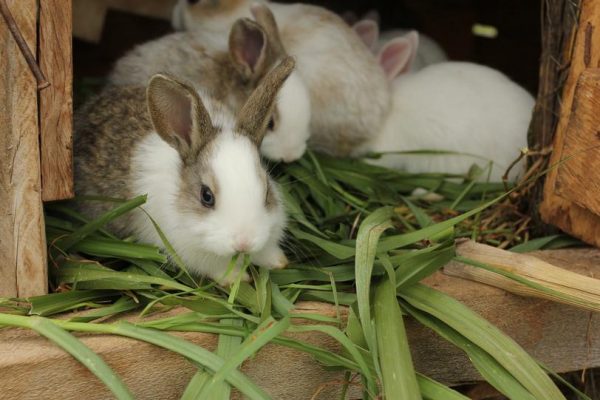
In the event that a farm with a large population, then of course you need to mow meadow grass.
Of these, aromatic and bitter herbs will be helpful:
- sagebrush;
- dill;
- chicory;
- yarrow
They improve the digestion of animals. They should not be given to lactating females, the milk will be bitter and the rabbits may refuse it, which will lead to death.
The list, what can not be fed rabbits:
- buttercup;
- hemlock;
- lily of the valley;
- Hellebore;
- bleached;
- celandine
These herbs should not be given to beasts. They are poisonous when fresh. When dried, the toxicity of these herbs is lost in whole or in part.
The transition to summer, green feeding of animals should take place gradually. It should be given at first in small portions and as the habituation is increased, increase the portions.
Rough food
What kind of grass can be given to rabbits? Dried useful herbs, that is, hay, straw, branches of trees and shrubs.
Hay - an important source of checkers. It is required to improve the digestion of rabbits. The best hay is considered - meadow, steppe. The meadows grow a large number of useful, medicinal herbs. Clover, alfalfa, chamomile, yarrow, mouse polka, medunits and many others.
It has great nutritional value for fattening rabbits. It is given in the period from late autumn to early spring. Properly dried grass has a fragrant smell and green color. Billet rate:
- per adult - 40 kg;
- for young animals up to 5 months of age - 10-15 kg.
For harvesting hay, the grass is mowed by hand, with a walk-behind tractor or mini-tractor with a trailed mower.After it lies in the sun and dries, it should be collected and folded in the stacks, which should subsequently be placed under a canopy.
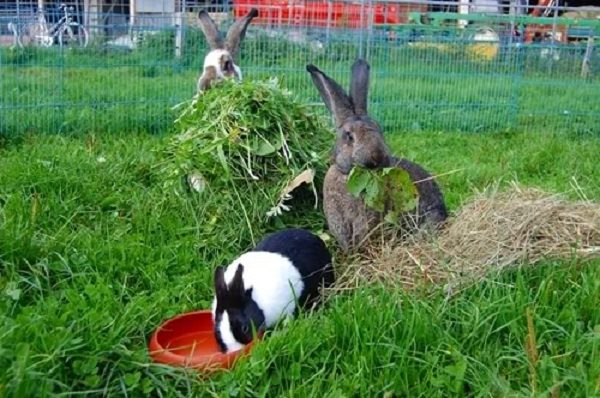
If there is no such, they are put on a specially designated place near the rabbit house, under the open sky and on the top of the head they pull a cap of plastic film. It is securely fastened so as not to be blown away. The film protects hay from moisture and mold.
Since rabbits need to constantly grind the incisors, they are given branches of some tree species. For this fit:
- birch;
- lime;
- aspen;
- maple;
- poplar;
- hornbeam;
- willow;
- cornel;
- ash trees;
- elm;
- verbal;
- pear;
- apple trees;
- acacia.
What to feed the rabbits so that they gain weight? It is useful to feed pine, spruce and juniper needles. It is cut from the branches and dried. This is an excellent source of vitamins such as: C, E and B vitamins, as well as carotene. It is given at the rate of 150-300 grams per 1 kg of live weight. As with any food, rabbits need to be taught to the needles gradually. Start with small doses and gradually increase to normal.
It is not recommended to feed branches to rabbits: elderberry, buckthorn, broom, bird-cherry, wild rosemary, as well as branches of the wolfberry. Many stone fruit trees contain harmful substances for animals. These include:
- cherry
- apricot;
- peach;
- cherry blossoms;
- plum.
According to the nutritional value, spruce feed is equivalent to meadow hay. Thin, dried branches with leaves are rich in amino acids, protein, carotene. They have a high content of fats and minerals.
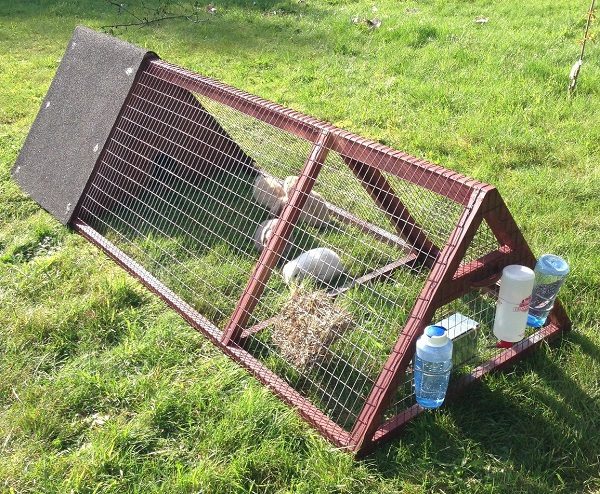
This feed is fed all year round. It is especially useful in winter and during the transition from winter feed to summer. If you have not harvested enough hay, then they can be replaced by half the diet.
Daily rate per rabbit:
- in winter - 150-200 grams;
- in the summer - 200-300 grams.
In this case, they need to feed the branches of oak and alder. But feeding a large number of birch branches should not be carried away. May cause kidney inflammation.
In order to properly prepare the branches, they must be cut with a thickness of not more than 1 cm. The billet is produced in the month of June in July, when they have the greatest nutritional value. Cut branches should be bundled and tied with a cord. Hang in the shade to dry.
Succulent feed
The structure of succulent feed contains a lot of structured water (70-80%). Because of this, they are easily digested and digested by the body. Same they are the source of such beneficial substancesas: fiber, vitamins, carbohydrates, proteins, minerals and vegetable fats. Rabbits are fed:
- fodder and sugar beet;
- potatoes (preferably boiled and in the form of a mix with mixed fodder);
- pumpkin;
- carrots;
- squash;
- Jerusalem artichoke;
- pumpkin;
- watermelon fodder;
- fodder cabbage (in limited quantities);
- silage
This is not the whole list of succulent feed eaten by animals. What is useful for rabbits each of the products of this list and what they like more?
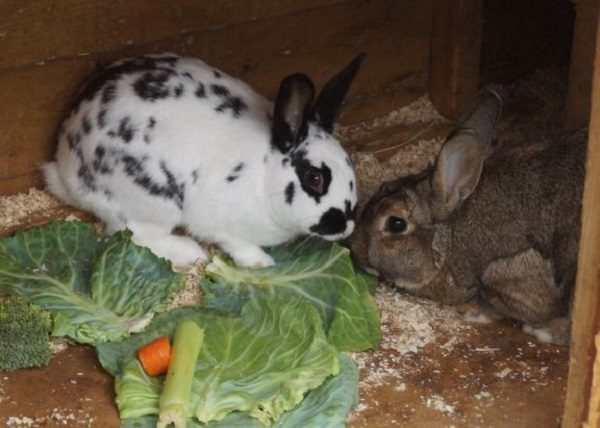
Potatoes
Potatoes have few vitamins, but it is rich in starch, which is easily digested and digested. Moreover, it is the most common vegetable garden.
Carrot
Carrots are rich in vitamins, essential oils, minerals and fatty acids. When it is fed in animals, an increase in appetite is observed. Distribute to animals raw whole or sliced.
Zucchini
Is it possible to give zucchini to rabbits? Zucchini is primarily a nutritious vegetable. It has a lot of structured water, which is useful for animals. Take into account the fact that when feeding this vegetable drinking water in drinkers should be limited. Zucchini is suitable for the manufacture of silage, which is fed to animals in winter. Vegetable fed in the summer and autumn. Until spring, it is poorly stored.
Pumpkin
Can rabbits be given a pumpkin? According to its properties similar to zucchini. It has a lot of vitamins. Carotene. Therefore, feeding this vegetable is beneficial for the organism of animals. You can give from autumn to spring, as it is well stored in winter. Before feeding, cut into pieces.
Cabbage
Cabbage is eaten by rabbits with pleasure, but must be given in limited quantities.Because after it, animals have bloating. Therefore, they need to be accustomed to this type of feed gradually. Cabbage contains many vitamins, water, fiber and trace elements necessary for active growth and reproduction.
Jerusalem artichoke
This vegetable goes to feed the tubers, as well as green mass. You can feed the animals until the frost, because it grows for a long time. Feeding tubers is an excellent prophylactic against intestinal diseases. To improve digestion.
The peculiarity of the vegetable is that it does not need to dig. He is very tolerant of frost and can be dug out in the spring and fed to animals. At the same time, it does not lose its beneficial properties.
Beet
The feed is only sugar or fodder. It improves blood composition. The composition of such useful substances for animals: sugar, proteins, fats and trace elements. The beet plant is laid in a silo, and the tubers are fed 50 grams per day per adult rabbit.
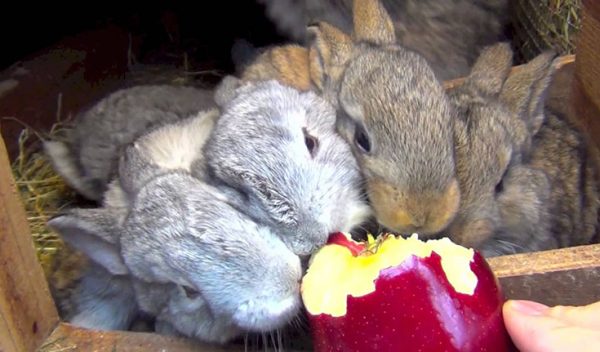
Vegetable and watermelon peels
Animals can be fed many wastes from the table, but can they be given watermelon peels, especially decorative ones? They eat small potatoes and peels, cabbage leaves, melon and watermelon rinds.After preparing winter salads, a lot of waste remains, which can also be fed to animals. They are well eaten with dried crusts of bread, but don’t give sweet flour to rabbits.
Can rabbits give apples, fruits and berries?
In the choice of fruits for animal feed, it is better to give preference to hard fruits. These are apples, pears. But given that they have a weak digestion, prone to distention of the intestine, it is better not to give fruits and berries. Stop picking vegetables.
Correct Concentrated Feed
Concentrated feeds include cereals (oats, wheat, barley, corn), feed and waste. They are high in calories, rich in protein and mineral elements, but they are low in vitamins.
Before feeding, they are ground and moistened, except whole grains. Of the grain is considered the best for feeding oats. It normalizes intestinal activity in rabbits. Oats are given to rats by producers, young rabbits up to 3 months of age and females. When fattening with wheat and barley, they grow fat.Therefore, these grains give in small quantities to young animals for fattening.
Oats
In its composition:
- 8.5% protein;
- 70% starch;
- 4-8% fat;
- 10.5% fiber.
It is fed whole, flattened or shattered.
Corn
Corn is more nutritious than oats, but tough for rabbits, so it is soaked, crushed. Sometimes fed corn porridge. More often it is mixed with other feeds. It should not exceed half the norm of the mixture.
Barley
It is used for fattening, as it is very nutritious. This food is not only possible, but also should be eaten by young rabbits. It is given in crushed or flattened out.
Wheat
They contain phosphorus. And:
- 13% protein;
- 5% fat;
- 60% nitrogen-free extractive substance;
- 7% fiber.
It is fed in a mix with a green grass, a rough and juicy forage.
Feed
Popular feed to use. It can be incompletely (loose) and complete (granular). Granulated feed is a balanced diet for animals. In these foods add vitamins, trace elements, as well as can be with antibiotics and drugs.
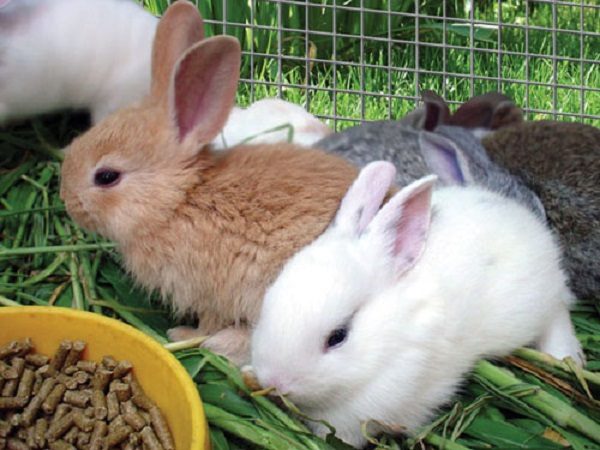
When feeding by frontiers, a quick average daily increase occurs.. It is:
- from 60-100 days - 35 grams;
- from 100-135 days - 30 grams.
For feeding rabbits, granulated feeds of two types are made:
- PC 90-1 - designed for feeding from 1 month to 6 months;
- PK 93-1 - for baby rabbits up to 3 months, and also used in fattening before slaughter.
Cake and meal
It is used in steamed form and used in a mixture with potatoes or mixed feed. Rich in iron and phosphorus. In use comes cake from soybean, flax, sunflower and hemp. Cotton cake is not used. It contains gossypol, this substance is poisonous to rabbits.
Meals contain less fat compared to the cake, but it is also rich in protein. In the feed used meal of flax, sunflower, soy.
For feeding rabbits, including dry fodder yeast and hydrolysis, beet pulp are used. They are given in mixture with other feeds.
From the above it is clear that rabbits for active growth and reproduction require a variety of food.It must be balanced and complete. Especially since any rabbit breeder can do this. The rate and composition of feed differs from the seasonality of the year. In the summer, the rabbits are given more green and juicy feed, and in the winter - juicy, concentrated and coarse feed.
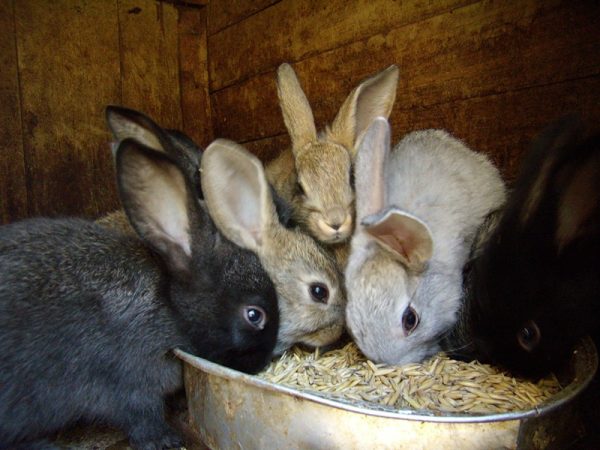
Food laid out in special feeders. They are made and installed so that the rabbits are not able to trample. Root vegetables must be cleaned of contamination. No need to give moldy or rotten food to animals.
How to feed animals in summer: herbs, vegetables, watermelons
Summer feeding of rabbits is fundamentally different from winter. This season they are given more green and juicy feed, which consists of mowed grass, branch feed, root crops and fresh vegetables. A small proportion of the diet consists of concentrated feed. So, how to feed the rabbits in the summer in the village or personal farm:
Rabbit for fattening:
- herbs - 700 grams;
- concentrated feed - 70 grams;
Males and females on vacation:
- herbs - 700 grams;
- conc. feed - 30 grams.
Males on bonding:
- herbs - 800 grams;
- conc. feed - 40 grams.
Suckling rabbits:
- herbs - 800 grams;
- concentration feed - 50 grams.
Young suckling rabbits:
- herbs - 900 grams;
- concentration feed - 50 grams.
Nursing rabbits - first half:
- herbs - 1200 grams;
- conc. feed - 70 grams.
Nursing rabbits - the second half + on the baby:
- herbs - 80 grams;
- conc. feed - 6 grams.
Juveniles from 1 month to 2:
- herbs - 300 grams;
- conc. feed - 20 grams;
- salt - 0.5 grams.
Youngsters from 3 months to 4:
- - herbs - 500 grams;
- - conc. feed - 45 grams.
Youngsters from 5 months to 7:
- - herbs - 600 grams;
- - conc. feed - 55 grams.
If branches and succulent fodder are used in feed, the grass cottage is cut in half. Grass should be dried. Salt is best given to the cells of rabbit in the form of lick, so they can control their own need for it.

What kind of food to give in the winter so that they can gain weight?
In winter, rabbits for heating should be fed with the best feed. Therefore, at this time the rate of concentrated and roughage increases. In addition, they are given root crops, silage. Consumption rates of different groups.
Feeding Rabbits:
- roughage (hay) - 150 grams;
- root vegetables - 500 grams;
- Concentrates - 80 grams.
Males and females on vacation:
- rough food - 150 grams;
- root vegetables - 150 grams;
- concentrates - 40 grams.
Males in mating:
- rough food - 150 grams;
- root vegetables - 200 grams;
- concentrates - 55 grams.
Sucker females:
- rough food - 180 grams;
- root vegetables - 200 grams;
- concentrates - 60 grams.
Young suckling females:
- roughage - 250 grams;
- root vegetables - 300 grams;
- concentrates - 70 grams.
Nursing females in the first half:
- - roughage - 200 grams;
- - root crops - 400 grams;
- - concentrates - 90 grams.
Nursing females in the second half + on the baby:
- rough food - 12 grams;
- root vegetables - 5 grams;
- concentrates - 7 grams.
Juveniles from 1 month to 2:
- roughage - 50 grams;
- root vegetables - 150 grams;
- concentrates - 35 grams.
Youngsters from 3 months to 4:
- roughage - 100 grams;
- root vegetables - 300 grams;
- concentrates - 55 grams.
Youngsters from 5 months to 7:
- rough food - 150 grams;
- root vegetables - 350 grams;
- concentrates - 75 grams.
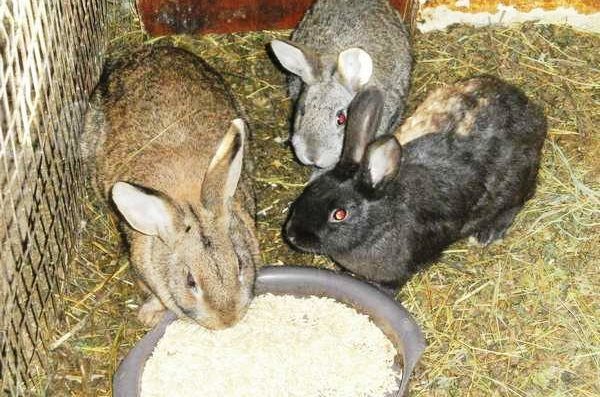
Diet rabbits in the village or on a personal farm
In order to make the diet of rabbits you need to take into account the time of year, what is the weight and age of the animal. As well as its physiological state. The rate of feeding is derived from the nutrient content in the feed:
- feed unit;
- protein;
- trace elements;
- vitamins.
In the daily diet should be present all the nutrients at the rate of feeding. During physiological dormancy, animals need nourishing food less than the succulent and lactating females, as well as young calves that are removed from the mother.
Rabbit breeders in the preparation of the diet should be borne in mind that for animals grown for meat the number of proteins increases, and the fattening period decreases. Those who want to get a quality skin ration should calculate the opposite. Harm to health does not bring the feeding of grass and hay. They can be given without restriction, but the rest of the feed should be given at the rate and according to the regime.
Feeding regime at home
Rabbit feeding mode must be observed, because with the timely distribution of food they begin to produce gastric juice, which is known to help better digest and process food. They grow and develop better. They approach the feeders at least 80 times, they often eat, but little by little.
Suppose a female during lactation and babies up to 2.5 months need to be fed 4 times a day. Young adults and adults need 2 x - 3 x times. Read more about winter and summer animals.
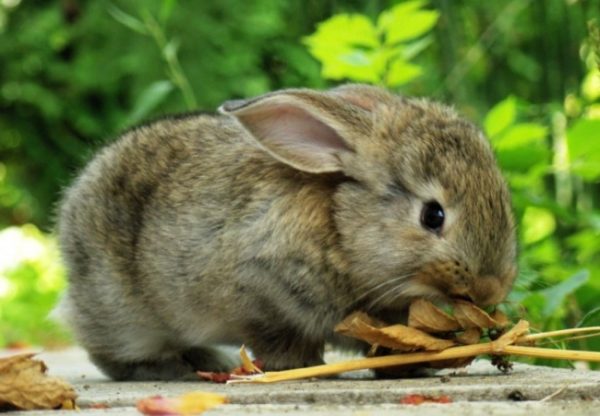
Winter: three meals a day:
At 8 am - we give half the rate of concentrates and hay;
At 12 days - give the roots;
At 17 in the evening - the second half of the concentrates and full feeds of hay and twigs.
Winter: 4 meals a day:
At 6 am - ⅓ concentrates and ¼ hay;
At 11 days - ½ root vegetables, ⅓ concentrates;
At 16 pm - ½ root vegetables, ½ hay;
At 19 pm - ¼ sen, ⅓ concentrates.
At night, animals feed in the feeder sprig feed.
Summer: 3 meals a day:
At 6 in the morning - full feeds of concentrates and the third part of the norm is grass;
At 15 days - the third part of the green food norm;
At 19 in the evening - full-feed concentrates, a third of green fodder, as well as branch feed.
Summer: 4 times a day feeding:
At 6 in the morning - the third part of the concentrate, the sixth part of the grass;
At 11 am - the third part of the concentrate, the sixth part of the green feed;
At 16 in the evening - full grass;
At 19 pm - the third part of the concentrate, the sixth part from the norm of green fodder and branches.
Vitamin and mineral supplements for rapid growth
In the summer, rabbits have enough vitamins in green grass and vegetables, but closer to spring, their reserves in the body run low and need to be replenished.
To replenish vitamin A and D, rabbit is injected into the feed fish oil or oil concentrate in ampoules.
- little rabbit - 0.5 grams;
- adults - 1 gram;
- suckling and nursing females - 3 grams.
Vitamin E deficiency can be replenished:
- green hay;
- baker's yeast;
- germinated grain;
- pharmacy drugs.
Bonemeal is injected into the diet:
- calcium 32 percent;
- phosphorus 15 percent.
Bone Ash:
- calcium 35 percent;
- phosphorus 16 percent.
Chalk: calcium 40 percent.
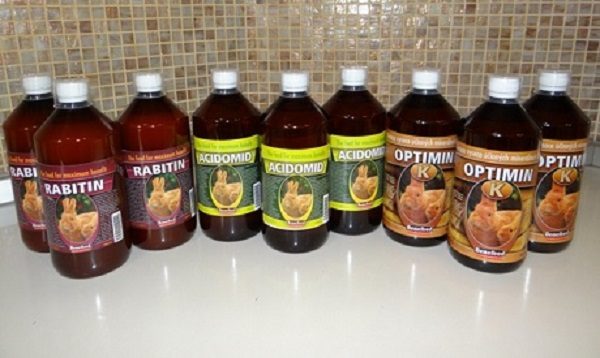
Salt is also important for rabbits. The consumption rate for young stock is from 0.5 to 1 gram per day. For adults from 1 to 1.5 grams. For fattening rabbits, the rate is increased to 3 grams. Since it is difficult to distribute such doses, it is more convenient to give the salt in the form of a lick. Spread salt pebbles in places not accessible for trampling. Thus, the rabbits themselves control the rate of salt intake.
What can not eat rabbits?
So, what can we feed the rabbits we have disassembled.We turn to the question that it is impossible to give the rabbits under any circumstances. These animals have a weak stomach with weak muscles. It must always have food and water. Their digestive process is designed so that food is pushed by food and therefore, to avoid digestive problems you should not keep them hungry.
It is also not recommended to give sour, salty or sweet food. From freshly cut grass they have a swelling of the intestines. Before feeding, it must be withered in the sun. When mowing, pay attention to the presence of toxic herbs. Root crops should not be given with contamination. Wash them before giving.
Not all plants are good for feeding animals. An excessive amount of cabbage may cause intestinal upset. Buttercup caught in the grass leads to diarrhea, poisoning and bloating. Dangerous flower such as chamber. Causes paralysis of the animal.
This family includes aconite. The animal has a strong drooling, convulsive state and slows the pulse.. Poisoning with this plant leads to the death of eared fish. From marsh marsh malt is a violation of the kidneys. You can not feed the rabbits with toxic plants:
- hemlock;
- mustard;
- colza;
- digitalis;
- dope
- spurge;
- Colchic and many others.
Farmers raising rabbits on a farm brings a good income. If feeding is organized properly, then there are no diseases of the digestive system.
A balanced diet contributes to the active development and reproduction of rabbits.
And finally, a small video on the topic of how to feed rabbits in winter:
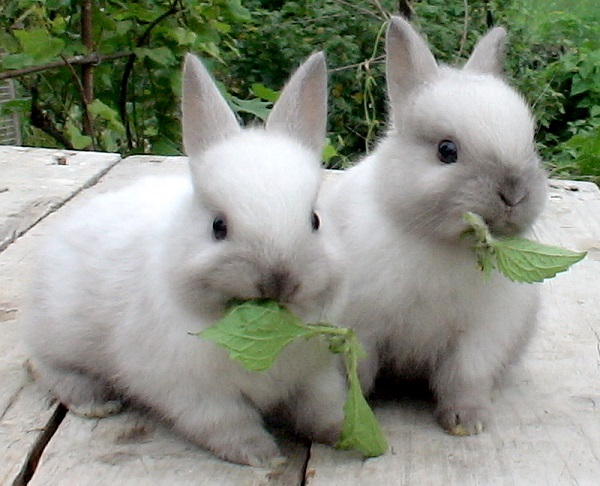
I would like to supplement the article a little with my experience. Rabbits are very gentle and it does not depend on the breed. In order not to hurt, you need to keep the usual guinea pig with rabbits, it is from folk methods that work in practice. pits and keep there, they do not hurt there.
Ivanyutka, and how guinea pig helps from diseases?